| Pages:
1
2
3
4
5 |
jdowning
Oud Junkie
    
Posts: 3485
Registered: 8-2-2006
Location: Ontario, Canada
Member Is Offline
Mood: No Mood
|
|
Sample #11 Walnut in plain water - marinated for 30 days. There was bacterial growth in the fluid and a slime on the surface of the sample. The fluid
was tinged a medium brown colour.
After boiling for 5 minutes, the sample was tied to the mold. It cracked at the ends like sample #9 and #10. The cracking of sample #9 is shown in the
attached image - similar to sample #10 after air drying for 24 hours.
A close inspection of sample #10 indicated that the cracks are being initiated in the late wood cells exposed on the surfaces of each sample. It can
be seen that - as there is very little 'run out' of the longitudinal grain in the Phase 2 samples - the open cell structures exposed at the surfaces
of the samples are relatively long and so constitute a weakness causing localised thinning of the sample as well as acting as stress raisers. The
exposed latewood cells appear in parallel groups on the surface because the samples are slab cut. Slab cut wood is also stiffer across the width of a
sample so may be more difficult to bend into a fluted section.
Contrast this with sample #7 from the Phase 1 tests - successfully bent without cracking. It so happens that the longitudinal run out of the Phase 1
samples is about 5 - 10 degrees so that the exposed cell structures are much shorter and more random in distribution. Also, these samples, being
quarter sawn, can flex more readily across the width of a sample so should be easier to bend into a fluted section.
It is anticipated that the remainder of the phase 2 samples will also crack when bent for the above reasons - but time will tell.
Longitudinal grain run out may turn out to be an important factor in order to successfully bend fluted ribs.
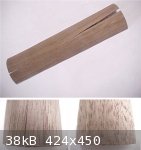
|
|
|
jdowning
Oud Junkie
    
Posts: 3485
Registered: 8-2-2006
Location: Ontario, Canada
Member Is Offline
Mood: No Mood
|
|
Sample #12 Walnut/50% glycerine- 50% alcohol marinade. Soaking for 31 days. Fluid tinged pale brown.
The sample cracked at one end during bending - length of crack is 3 cm (1.2 inches).
The attached image is the end grain of sample #12 after 24 hours air drying. The measured thickness is 0.94 mm (0.037 inch) so there may have been
some reduction in thickness prior to marinating of around 15%. The camera was hand held (not recommended for macro photos!) but the image is clear
enough and illustrates the problem with all of the Phase 2 test samples. It can be seen that the early-wood cells are of significant diameter compared
to the thickness of the sample (looking like Swiss cheese - or worm eaten wood!). As there is no longitudinal grain 'run out' in the Phase 2 samples,
the exposed cells, on both sides of the sample, are quite long, creating a weakness and points of high stress when subject to bending under tension-
equivalent to scoring the samples with a knife.
Sample #13 Walnut/Household Ammonia solution. Soaking for 32 days. The marinade fluid was a deep mahogany brown. The sample was very pliable and after
boiling for 5 minutes was tied to the mold without cracking. This is an encouraging result - particularly in view of the problem with Phase 2 samples
(although the sample may still crack after air drying for 24 hours). An ammonia solution in water of 5% to 10% is not supposed to be effective in
softening wood (unlike liquid ammonia) but both Phase 1 and Phase 2 tests involving household ammonia have both produced promising results so far.
The last test in Phase 2 will be Walnut/Wood Alcohol.
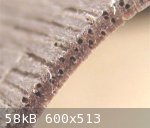
|
|
|
jdowning
Oud Junkie
    
Posts: 3485
Registered: 8-2-2006
Location: Ontario, Canada
Member Is Offline
Mood: No Mood
|
|
Sample #13 has been released from the mold after air drying at a room temperature of 65 F (18 C) and relative humidity of 50% for 24 hours. The sample
has not cracked. However it had shrunk and distorted significantly (shriveled) as can be seen in the attached image where the sample is shown along
side sample #11 for comparison. Compared to sample #11, maximum shrinkage across the width of the sample (measured in the middle) is about 20% but
there is no measurable shrinkage in the length. The Ammonia solution has softened the cell walls of the wood to the point where they have shrunk in
size during drying. The ends of the sample that were not restrained by the binding tape have become 'bell shaped'.
Had the sample been quarter sawn, it is expected that the degree of shrinkage and distortion would have been less.
So - no matter what the experts say - a 5% to 10% solution of Ammonia in water will work in softening the cell wall - like liquid Ammonia does - it
just needs more time. Liquid Ammonia presumably softens the wood very quickly - so is commercially more viable. No doubt if wood is left in liquid
Ammonia for an extended period, it would also suffer the same degree of shrinkage and distortion? Clearly, in this test, the marinating time has been
excessive (so the results are a failure as far as bending is concerned) but it does demonstrate the softening power of Ammonia. Shorter marinating
times and/or a more dilute Ammonia solution would likely be more successful. More testing is required in order to find the optimum set of conditions
for bending using a dilute Ammonia solution.
Sample #14 Walnut in Wood Alcohol. This sample has been marinating for the same period as the other samples in
Phase 2 but - due to a leaking Ziploc bag - was found to have dried out when inspected on the 7th Dec. Since then the sample has been re-marinating in
a fresh solution of wood alcohol but it is now difficult to know if the marinating period should count as 14 days or 33 days. Nevertheless, it was
decided to go ahead with bending the sample. After boiling in water for 5 minutes, the sample was tied to the mold without cracking and left to dry
for 24 hours.
Another promising result!
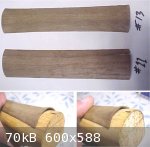
|
|
|
jdowning
Oud Junkie
    
Posts: 3485
Registered: 8-2-2006
Location: Ontario, Canada
Member Is Offline
Mood: No Mood
|
|
Sample #14 cracked at both ends after drying for 24 hours with one crack measuring 2 cm long and the other 1 cm. Nevertheless, this is a positive
result as allowance can be made to trim a rib after bending.
The attached image shows a cross section of sample #13 (cut in the middle of the sample) compared to sample #11 to illustrate the degree of shrinkage
after marinating in the Ammonia solution. Note that the radius of the fluting is also reduced.
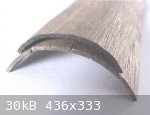
|
|
|
jdowning
Oud Junkie
    
Posts: 3485
Registered: 8-2-2006
Location: Ontario, Canada
Member Is Offline
Mood: No Mood
|
|
The attached image shows the cell structure of sample #13 (at the mid section) after marinating in Ammonia and drying compared to sample #12 end
grain. It can be seen that the larger diameter early wood cells have been reduced in size after drying and the structure of the wood has become
compressed and more compact.
Had the sample been quarter sawn there would have been less reduction in the width of the sample but a greater reduction in thickness. This will be
worth another test as, after Ammonia treatment, wood becomes quite plastic in nature so should have the advantage of allowing greater scope for more
extreme bending of the wood - perhaps without the need for heat.

|
|
|
jdowning
Oud Junkie
    
Posts: 3485
Registered: 8-2-2006
Location: Ontario, Canada
Member Is Offline
Mood: No Mood
|
|
At this stage it might be worth briefly summarising the overall results from the Phase 1 and Phase 2 trials.
All of the marinating fluids provided a degree of softening of the samples allowing them to conform - some better than others - to the mold curvature.
However, the most successful result was sample #7 Black Walnut marinated for 10 days in a 50/50 mixture of household Ammonia solution and Wood Alcohol
(Methanol). This sample retained the transverse and longitudinal curvatures of the mold when released after drying on the mold for 24 hours. Measuring
the sample again today - since 15th November - the longitudinal curvature is unchanged at 69 cm (27 inch) radius but the radius of the fluting has
decreased slightly to less than 18 mm radius (i.e. it is more fluted). The thickness is unchanged at about 1.02 mm. There are no visible cracks. The
sample is therefore judged to be stable
The Phase 2 trial with Walnut sample #13 marinating for 32 days in Household Ammonia demonstrated that even a dilute solution of Ammonia in water does
have a significant plasticising effect on wood. In the case of sample #13 although the sample shrank during drying and the cell structure became
compressed under the bending stresses, the sample did lose its plasticity and become hard again on drying.
The 50/50 blend of Ammonia/Methanol was just a guess but it may be that the alcohol was only a diluting agent for the Ammonia and that water might
have done just as well in place of Methanol. It is possible that by using Ammonia solution as a marinating fluid (under optimum conditions yet to be
determined) that ribs might be bent without use of heat - and also conform to the more extreme curvatures required of oud or lute fluted ribs.
Samples of Maple were more difficult to bend than Walnut possibly because the Walnut has larger, thin walled, early wood cells than maple so the
marinating fluids can act in softening the wood more quickly. However, it is likely only a matter of adjusting the marinating period to allow woos
species with small cells more time to soften - or to adjust the strength of the marinating fluid - or a combination of both.
The grain direction of the wood seems to be important for successful bending. The walnut samples in Phase 1 were quarter sawn (end grain running
vertically) and with a longitudinal grain 'run out' of about 5 degrees. The quarter sawn grain provides the greatest degree of transverse flexibility
and the short longitudinal grain reduces the stiffness in that direction both factors allowing easier compound bending. Presumably the greater the
degree of longitudinal grain run out the greater the degree of flexibility but this would have to be tested to confirm. The reduced stiffness of the
unbent rib blanks should not be a problem as the fluted ribs in the finished instrument would not only be thin and light but very stiff by virtue of
their geometry.
So where to go from here? Phase 3 trials will now focus on Household Ammonia solution as the most promising marinating fluid to try to establish the
optimum fluid concentrations and marinating periods for a selection of woods - including tropical hardwoods - using the original mold and sample
dimensions of Phase 1 and 2.
Phase 4 trials will be to test bend full length ribs for a Dias guitar.
Phase 5 trials will be to attempt to bend fluted oud or lute ribs - probably with the rib blanks in a fully plasticised condition. Phase 4 an 5 trials
will require a new male mold for the Dias ribs as well as a sealed chamber of the required length to hold the longer blanks while marinating.
This will all take some time to complete but I am now more optimistic in being able to succeed in this investigation - certainly with the guitar ribs
but also, possibly, with the more challenging oud ribs.
|
|
|
jdowning
Oud Junkie
    
Posts: 3485
Registered: 8-2-2006
Location: Ontario, Canada
Member Is Offline
Mood: No Mood
|
|
For those who might be interested, here are three scientific papers about wood degradation caused by bacterial and other action - as found in wood
taken from archaeological sites in Ancient Egypt, Turkey and elsewhere.
Hopefully short term bacterial action - deliberately employed to temporarily soften the cell structure of wood - will be less destructive than in
those woods exposed for thousands of years. This would, presumably, depend upon the bacteria being destroyed and the conditions required for bacteria
to thrive being removed - as should be the case for dry, seasoned woods used in musical instruments.
http://aic.stanford.edu/jaic/articles/jaic33-01-005.html
http://forestpathology.cfans.umn.edu/pdf/IBBreview2000.pdf
http://www.pnas.org/content/98/23/13346.full.pdf+html
|
|
|
jdowning
Oud Junkie
    
Posts: 3485
Registered: 8-2-2006
Location: Ontario, Canada
Member Is Offline
Mood: No Mood
|
|
In order to establish the length of time it takes for Household Ammonia solution to plasticise wood, Walnut samples are to be subject to yield
testing. The marinating fluids will be Household Ammonia - undiluted; 50% Ammonia solution/ 50% water; 50% Ammonia solution/ 50% Wood Alcohol.
The marinated samples will be tested every 24 hours by clamping each sample in a test rig, applying a standard, fixed load to the end of each sample
and measuring the deflection at the load point on the sample. The attached images show the rig set up.
Samples in an untreated, (i.e. unsoftened) state will retain their elasticity under the (briefly applied) test loading - that is when the load is
removed the sample will spring back to its original position on the rig. At some point in time, however, the sample is expected to soften and so will
lose its elasticity - i.e. it will not return to its original unloaded position on the rig. This will be the initial yield point of the sample and
will be an indication of how long a sample must be marinated to become plasticised. At least, that is how I see the test working so we will see how it
goes.
Also, in order to get a better idea of what happens to the cell structures of different wood species when plasticised by Ammonia, several test samples
- cubes measuring about 12mm (0.5 inches) on each side - have been left to soak in Household Ammonia solution for 30 days in a sealed jar. The wood
samples are Vine, White Ash, Black Ash, White Elm, Black Walnut, Beech, and Indian Rosewood.
There was an immediate action noted on adding the Ammonia solution - the fluid quickly becoming a dark brown colour. So something is definitely going
on there. After 30 days the samples will be boiled in fresh water for 10 minutes and the softened end grain sliced with a razor in preparation for
taking digital micro images of the cell structures after drying.
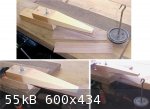
|
|
|
jdowning
Oud Junkie
    
Posts: 3485
Registered: 8-2-2006
Location: Ontario, Canada
Member Is Offline
Mood: No Mood
|
|
The Walnut test samples for the yield test have been marinating for 5 days (120 hrs) and have been tested daily. Each sample has been loaded with a
constant load and the deflection at the end of the sample measured with calipers. This method of measurement, in retrospect, is not very satisfactory
but gives a rough idea of the softening effect of the marinating fluid with time.
The Ziploc bag containing the Ammonia solution marinade has started to leak so, today the sample has been transferred to a new bag with fresh marinade
so this is not a set back.
Preliminary observations.
The test samples in the Ammonia solution and Ammonia solution diluted 50% with water have shown the greatest increase in plasticity with increased
deflections under constant load of about 115 % over 120 hours. This compares with an increase of about 25% for the sample marinated in the
Ammonia/Wood Alcohol solution. Clearly, the wood alcohol has a moderating effect and the test sample does not show the same distortion (buckling and
twisting) as the other two test samples.
It is estimated that the first two samples are close to their yield points i.e. being fully plasticised.
The tests continue.
|
|
|
jdowning
Oud Junkie
    
Posts: 3485
Registered: 8-2-2006
Location: Ontario, Canada
Member Is Offline
Mood: No Mood
|
|
The wood samples - cubes measuring 0.5 inch (13 mm) on all sides - have been marinating in Ammonia solution in a sealed jar for 10 days after which
time they were removed for examination. Each sample was boiled in water for about 5 minutes and allowed to dry. The duration of the test was reduced
as the softening effect of the Ammonia solution appears to be much more rapid than previously thought.
After drying, each sample was observed to have shrunk to a degree - shrinkage being greater along the growth rings than radially across the rings as
it would be if the wood had been dried in the usual manner from being freshly cut. The least amount of shrinkage was found in the sample of Indian
Rosewood (closely followed by American Elm) and the greatest amount in a sample of White Ash.
Images of the cell structures of each sample - before and after marinating - will be posted separately for information.

|
|
|
jdowning
Oud Junkie
    
Posts: 3485
Registered: 8-2-2006
Location: Ontario, Canada
Member Is Offline
Mood: No Mood
|
|
The most dramatic example of wood shrinkage after marinating in Ammonia solution is seen in the sample of White Ash. The sample, after drying is now
calculated to be only 56% of its original volume. This would imply an increase in Specific Gravity from about 0.6 to 1.0 assuming no loss of weight in
the marinating process only shrinkage. There is also likely to be an increase in hardness of the wood - although I have no means of measuring relative
hardness to verify this assumption.
The attached image shows the appearance of the sample after marinating and drying compared to its original appearance - both being represented to the
same scale before and after. The reference scale is in mm.
The dark appearance of the sample is because all of the samples were marinated together in the same sealed vessel. The Ammonia has extracted wood
dyes from the Indian Rosewood and Walnut samples which in turn has stained all of the samples a dark brown colour.
It so happens that the Ash sample has been quarter sawn with the growth rings running horizontal in the image. The greatest amount of shrinkage is
along the growth rings (transverse) with a lesser degree across the growth rings (radial) as expected in normal seasoning of wood. However, normal
tangential shrinkage in Ash is about 1.6 times greater than radial shrinkage when drying the wood from green to oven dry moisture content whereas, in
this case, the tangential shrinkage is 4 times radial.
As the latewood cells of Ash are small and thick walled compared to the large, thin walled, early wood cells there is differential shrinkage between
early wood and latewood cells in each growth ring producing the unusual rippled effect observed at the edge of the sample.

|
|
|
jdowning
Oud Junkie
    
Posts: 3485
Registered: 8-2-2006
Location: Ontario, Canada
Member Is Offline
Mood: No Mood
|
|
In contrast to the 'extreme' shrinkage seen in the White Ash sample the attached images show the American Elm sample after marinating for 10 days
together with an untreated sample of Elm - both to the same scale. The reference scale is in mm.
In this case the volume of the marinated sample is calculated to be about 92% of its original size. This shrinkage implies an increase in Specific
Gravity from 0.5 to about 0.54.
Both White Ash and American Elm, outwardly, have similar ring porous cell structures so it is not clear why the shrinkages should be so significantly
different between the two woods. One clue may be in the amount of darkening observed in the marinated samples - due to absorption of the dark brown
dye in the marinade. The colour of the Ash sample is dark whereas that of the Elm is quite pale - indicating that the Ash cell structure is more
porous and might, therefore, be expected to react more quickly to the marinade.

|
|
|
jdowning
Oud Junkie
    
Posts: 3485
Registered: 8-2-2006
Location: Ontario, Canada
Member Is Offline
Mood: No Mood
|
|
The attached images show the marinated sample of Vine wood together with an untreated sample. Vine wood also has a ring porous cell structure but,
unlike Ash and Elm, large early wood cells predominate. The reference scale is in mm.
The calculated volume of the sample after marinating is 71% of its original volume and the sample is a dark colour indicating a relatively heavy
absorption of the marinating fluid. The change in Specific Gravity implied by this degree of shrinkage is an increase from 0.55 to 0.79 and
corresponding increase in hardness.
It is perhaps surprising that the Vine sample did not show a greater amount of shrinkage because of its open cell structure. Perhaps the wide rays
running radially on each side of the rows of cells support the cell walls against shrinkage - both in a transverse and radial direction - behaving a
bit like reinforcing rods in compression?
To summarise, the least affected sample is Indian Rosewood that, after 10 days marinating, showed no measurable shrinkage.
American Elm is next in decreasing order, shrinking in volume to 92 % of original size. S.G increase from 0.5 to 0.54.
Vine is 71% original size. S.G. increase from 0.55 to 0.78.
Black Walnut is 70% original size. S.G. increase from 0.55 to 0.79.
European Beech is 70% original size. S.G. increase from 0.64 to 0.91.
Black Ash is 59% original size. S.G. increase from 0.49 to 0.83.
White Ash is 56% original size. S.G increase from 0.6 to 1.0.
Presumably, the more resistant a wood is to absorption of a marinade the longer the time it will take for the wood to be softened - although this
would require further testing to verify. Perhaps the Rosewoods, for example, are too oily and 'waterproof' to be significantly affected regardless of
the time soaking in the marinade?
Note that all of the test samples were fully seasoned and dried prior to marinating. The Black Ash and Black Walnut samples are both over a century
old and the Beech about 60 years old.

|
|
|
patheslip
Oud Junkie
    
Posts: 160
Registered: 5-24-2008
Location: Welsh Marches
Member Is Offline
Mood: smooth
|
|
excellent stuff
|
|
|
jdowning
Oud Junkie
    
Posts: 3485
Registered: 8-2-2006
Location: Ontario, Canada
Member Is Offline
Mood: No Mood
|
|
In the meantime the yield tests for Walnut samples marinating in Ammonia solution, 50/50 Ammonia solution and water and 50/50 Ammonia in Wood Alcohol
have been completed.
The purpose of the yield test is to determine the length of time it takes for a marinated sample to become plastic.
Samples were slab cut from the same piece of Black Walnut (over 100 years old so well seasoned) used in the bending trials previously posted. Each
sample measured 7 inches long X 1.5 inches wide X 0.045 inches thick (178 mm X 38 mm X 1.14 mm) that allows an inch (25 mm) to be clamped in the test
rig leaving a 6 inch (152 mm overhang).
Each marinating sample was removed from the marinade each day (every 24 hours) and loaded as a cantilever beam in the test rig - firmly clamped at one
end with a fixed weight attached to the free end. The deflection at the free end was measured using dividers.
A sample was also tested under load to establish that the chosen loading did not produce yielding in a dry untreated sample.
The results are shown on the attached graph.
The yield point (point A) for each sample was achieved for the Ammonia solution marinade in about 3 days, for the 50/50 Ammonia - water marinade in
about 4 days and for the 50/50 Ammonia - Alcohol marinade in about 8 days. All of the deflection/time curves are of a similar general shape.
The test was continued after the yield points had been reached - just to see what happened - but was terminated after 13 days as it became
increasingly difficult to measure the more extreme deflection. (This difficulty is apparent in the more erratic data points measured after day 10 for
the sample marinated in the Ammonia solution).
A further test is in hand to find out how the untreated sample soaked in water responds. These results will be posted later for comparison and
information.
This simple yield test method should be useful in establishing the optimum time to marinate a particular species of wood prior to boiling and hot
bending. Clearly, from the results of the soaking tests previously posted, Indian Rosewood or Elm will take much longer to become plasticised than
Black Walnut.
For some unknown reason, Wood Alcohol has a (beneficial?) modifying effect and significantly slows down the action of the Ammonia solution on the wood
fibres.
It should be noted that the force producing bending of the samples is not constant but reduces with increased deflection. This force - or more
precisely bending moment - is the product of the applied weight and its horizontal distance (W multiplied by L) from point X the location of the
maximum bending stress and will account in part for the gradual flattening of each curve after the yield point has been passed. So. for example the
sample soaked in Ammonia solution on day 13 experienced a bending moment of about 70% of that on the first day. This does not affect the final results
of the test.
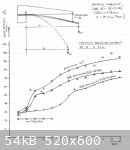
|
|
|
jdowning
Oud Junkie
    
Posts: 3485
Registered: 8-2-2006
Location: Ontario, Canada
Member Is Offline
Mood: No Mood
|
|
It should be emphasised that the marinated wood only remains plastic when it is wet becoming hard (yet retaining some flexibility) after drying.
The attached image shows the sample that had been marinating in Ammonia solution for 13 days (and subject to 13 loading cycles) after being allowed to
dry for 24 hours - compared to a dry untreated sample.
It is interesting to note that the sample has retained a 'memory' reflecting the internal stress levels experienced during the test. The dried sample
is heavily fluted at the point of maximum bending stress (point X) as well as being slightly curved longitudinally - the degree of fluting diminishing
towards the point of loading W. The fluting occurs naturally due to the balancing of the transverse and longitudinal internal stresses - all without
use of a mold!
After drying the sample was found to have shrunk about 8 % in width and 11 % in thickness the length being unaffected.
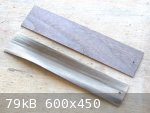
|
|
|
jdowning
Oud Junkie
    
Posts: 3485
Registered: 8-2-2006
Location: Ontario, Canada
Member Is Offline
Mood: No Mood
|
|
For the past two weeks, some additional yield tests (using the test rig) have been under taken with the following results.
Test Sample #1 - Walnut sample, slab cut, marinated in water. The sample measured 0.045" thick X 1.5 " wide X 6" long (cantilever) - (1.15 mm X 38 mm
X 153 mm) - as for the previous samples tested.
Test Sample #2 - Indian Rosewood marinated in Ammonia solution. Test sample dimensions as before.
The attached image shows a plot of deflection against time (14 days) for the two samples.
Sample #1 showed a slight increase in softening (2 mm deflection) after 1 day marinating in water, but no further softening thereafter.
Sample #2 showed a steady softening (10 mm deflection) after marinating for 5 days, but no further softening thereafter.
This result correlates the previous soaking tests posted that proved Indian rosewood to be largely unaffected by immersion in Ammonia solution.
On conclusion of the marinating/yield testing after two weeks, both samples were subjected to a boiling test. Each sample was immersed in boiling
water and subject to yield testing. As the test samples were thin and quickly lost heat they were repeatedly subjected to immersion in boiling water
for 1, 2, 3, 4, 5 and 10 minute periods - yield deflections measured after each immersion period (so the total immersion - in boiling water - of each
sample was 25 minutes).
The attached plot demonstrates the significant relative softening effect of immersion in boiling water for both samples.
An additional test was undertaken on an un-marinated sample of Indian Rosewood - for comparison purposes. This sample was subjected only to boiling in
water with deflections measured at intervals of 1, 2, 3, 4, 5 and 10 minutes - as for samples #1 and #2. The deflection curve is represented as A on
the attached graph.
It would appear from this data that Indian Rosewood is only slightly softened by immersion in Ammonia solution - an increase of about 25% after 5 days
of cold immersion. Boiling the sample then further increased the softening affect by about 250%. Therefore, the difference in softening effect of
immersing a sample in ammonia solution for 5 days and then boiling the sample for 3 minutes compared to just boiling a sample in water for 3 minutes
is about an 18% increase.

|
|
|
suz_i_dil
Oud Junkie
    
Posts: 1061
Registered: 1-10-2008
Member Is Offline
Mood: No Mood
|
|
Hello
I was just looking at a video, a study of a 16th century vihuela in order to copy it.
By their studies, they assume the fluted ribs were made in an high range of temperature and humidity. Their conclusion is the fluted ribs were made in
press ( " sous presse " in french, don't know the exact translation ), on a mold, but without more precision on the technique in the video.
I thought it may interest you.
http://www.savoirs.essonne.fr/sections/ressources/images-video/reso...
Regards, and once again thank you for sharing your very interesting works.
|
|
|
fledelis
Oud Admirer

Posts: 6
Registered: 8-29-2006
Location: France
Member Is Offline
Mood: No Mood
|
|
Thanks for the link. Unfortunately scientists can't really explain anything where practical experience is all that is necessary. I looked another day
again at Alexander Batov's web site who seem to be able to bend fluted ribs from the most demanding exotic wood species: king wood, rosewood, ebony,
cocobolo, satin wood. So I would imagine walnut would be just a breeze for him  Just have a look if you've never seen it:
Just have a look if you've never seen it:
http://www.vihuelademano.com/index.html
In one of the previous discussions on fluted ribs on this forum I've already mentioned that I saw Alexander's vihuelas on the exhibition in London
several years ago and they look absolutely stunning. I've never seen the work like that before. The very thought that he soaks the ribs in order to
bend them would seem to be highly unlikely. Would you really want to soak king wood or cocobolo for example? Wouldn't it spoil the wood? I surely
appreciate the work published on these pages although I'm not actually sure that the chosen method is the right one. Thanks for sharing your thoughts
and ideas anyway.
|
|
|
jdowning
Oud Junkie
    
Posts: 3485
Registered: 8-2-2006
Location: Ontario, Canada
Member Is Offline
Mood: No Mood
|
|
Thank you suz_i_dil.
The video is nice and clear but the audio is less clear (to me) so I shall need to take some time to listen more carefully in order to get a better
understanding of all that is being said.
The instrument under discussion is one of three surviving instruments considered to be possible vihuelas - two being in Paris and the third in South
America.
This vihuela is in the Cite de la Musique collection catalogue E.0748 recently 're-discovered' by Joel Dugot and reported in detail in his research
paper " Un nouvel exemplaire de vihuela au musee de la musique" published in 1998. This paper contains a lot of detail of interest to the luthier -
sound board thicknesses etc. In particular, concerning the fluted ribs of the instrument, Dugot observes that "La mise en forme a ete realisee par
pliage a chaud" and also states that "On note de nombreuses traces de brulure du bois sur les faces interns" - which I take to mean that the ribs were
hot bent and that numerous traces of scorched wood are in evidence on the interior surfaces.
On the video, Stephane Vaiedelich states that the ribs were bent at high temperature and high humidity on a two part compression mold (? just a guess
as I do not know the exact translation of the technical term 'sous-presse'). The high humidity reference is interesting.
Many copies of the instrument have been made by a number of different makers in recent years, the first being by London based luthier Stephen Barber
in 2001 after examination of the instrument in Paris and determination, by experimention, of a reliable method for bending the ribs. The full story
can be found on his website at:
http://www.lutesandguitars.co.uk/htm/cat.htm
check - 12. Vihuela, viola da mano and 14. Footnotes.
Needless to say, Barber does not reveal the method that he uses (which clearly works but may not be how it was done by the original maker - nobody
knows that). Barber does say, however, that steaming the wood (apparently used by some makers) is not the method he employs and is not to be
recommended. So perhaps the high humidity mentioned by the museum (if they have actually developed and tested a bending method) is a result of
pre-soaking the wood followed by scorching the wood to shape over a suitable mold with a hot iron?
I shall test this possibility as part of the on going trials reported on this thread. The procedure will be to marinate for a specific period of time
- determined by wood species and marinating fluid. Placing the blank on an open mold, heat will be applied with a hot iron (at scorching temperature),
bending the blank little by little over the mold followed by applying a matching upper mold piece to hold everything in place and to shape on the
lower mold form until the bent rib has fully dried.
The extra heat involved compared to simply heating the test pieces to 100 C should make a difference - particularly with the harder to bend
species.
Watch this space!
|
|
|
suz_i_dil
Oud Junkie
    
Posts: 1061
Registered: 1-10-2008
Member Is Offline
Mood: No Mood
|
|
Don't hesitate if a you need a few help in understanding some french ressource, but my english is limited, and I think more than your french. "Sous
presse" indeed refer to a process of compression on a mold.
Regards.
|
|
|
jdowning
Oud Junkie
    
Posts: 3485
Registered: 8-2-2006
Location: Ontario, Canada
Member Is Offline
Mood: No Mood
|
|
Thank you for your observations fledelis. I am already familiar with the work of Alexander Batov but I don't know what method he (or other makers )
uses to bend fluted vihuela ribs either.
I have no interest in making instruments for sale so this investigation is pure curiosity on my part - with no preconceived ideas - just to find out
where it might lead, which, of course, might be nowhere in particular. However, unlike many professional luthiers who, understandably, would never
share their knowledge for fear of losing business - I have no such qualms. If the results of my investigations are novel enough to be of some
practical use or interest to others - great - if not, I will not lose any sleep over it!
Certainly, Batov would have no trouble dealing with Walnut compared to say Indian Rosewood or Cocobolo - as my preliminary tests have confirmed. I
have initially used Walnut simply because it is one of the well seasoned materials that I have immediately to hand (Walnut, incidently ,was originally
used for making vihuelas - so perhaps my first attempt at a fluted back vihuela - for my own use - will be made from Walnut).
However, my ultimate objective here is to produce bent (not carved) fluted oud/lute ribs - a much more difficult proposition than bending the
relatively shallow curve of of a fluted vihuela rib I would imagine. I likely will not succeed but there is no fun in not trying.
Spoil the wood? Perhaps - if the marinating period is prolonged but, as my last tests have indicated, 'exotic' woods may not be significantly softened
by marinating - heat having a proportionally greater effect. However, what I find interesting is that - for some wood species at least - marinating
appears to significantly modify the cell structure - changing the properties in a way that, perhaps, might be beneficial (harder and denser) for
instrument making. Early days to judge however.
|
|
|
jdowning
Oud Junkie
    
Posts: 3485
Registered: 8-2-2006
Location: Ontario, Canada
Member Is Offline
Mood: No Mood
|
|
Thanks for your kind offer suz_i_dil.
My 'ear' for spoken French has faded in sensitivity through lack of practice in recent years so - although I think that I have a fair general
understanding of what is being said on the video, in some spots the voice faded when the words were spoken so quickly that I could not fully
understand the detail. For example at the end of the section describing methods used to determine the wood species, and their geographical origins, a
number was mentioned (?) that I thought might be the age of the sound board wood but I couldn't quite catch it. Also, when talking about the
examination of the end grain of the ribs there was some mention - I thought - of a progressive deformation of the cell structure but again the words
were spoken very quickly and the voice faded so I am not sure. Help!
The bound document that seemed to be a research paper in the video looked interesting. I wonder if copies are available for purchase from the Museum?
I imagine, also that working drawings of the vihuela are available for purchase but I am not sure from where these may now be obtained as the whole
organisation of the museum seems to have changed in recent times.
However, when I eventually build a version of a fluted back vihuela it will be a scaled down version with string length of somewhere between 56cm and
58cm so I likely already have sufficient information to proceed when ready.
|
|
|
suz_i_dil
Oud Junkie
    
Posts: 1061
Registered: 1-10-2008
Member Is Offline
Mood: No Mood
|
|
he is saying that the instrument is from 16 th century, knew by " organologic " studies, and the soundboard in spruce from year 1494 ( he says
quatorze cent quatre vingt quatorze which is the same than mille quatre cent quatre vingt quatorze ). For the soundboard they know by the " dandro or
dantrochronologie " which is a study of the growth of the wood.
For the ribs ( les cotes ) he says they are en "bois dessus", : the wood from up, as if we were looking at the wood from up to down, that's an
ebenistery terminology. The ribs have a systematic botanic deformation between the middle and the side of the ribs which allow them to assume they
were made by a compression process.
It may be possible to get a copy of their work, they are a team of scientists so very often this kind of work lead to a publication. Anyway it worth
asking, let me know if you have difficulties to contact them.
Regards
|
|
|
jdowning
Oud Junkie
    
Posts: 3485
Registered: 8-2-2006
Location: Ontario, Canada
Member Is Offline
Mood: No Mood
|
|
Thanks suz_i_dil.
I shall view the video a few more times for practice! I caught the '94' of the year but didn't hear the 'cent'. So the soundboard must have been about
50 years old or so before being incorporated into the vihuela.
Presumably there must be a greater deformation or collapse of the cell structure in the centre of the rib than at the edges? Does 'bois dessus' mean
'quarter sawn' - that is with the grain running across the thickness of the rib section rather than across the width of the rib ('flat sawn/)?
I will check the possibilities about the publication.
|
|
|
| Pages:
1
2
3
4
5 |